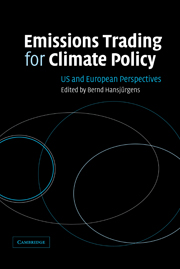Book contents
- Frontmatter
- Contents
- List of figures
- List of tables
- List of contributors
- Preface
- List of abbreviations
- 1 Introduction
- Part 1 Regulatory instruments for climate policy: theoretical aspects
- 2 Designing instruments for climate policy
- 3 Technical innovation and design choices for emissions trading and other climate policies
- 4 Incentives to adopt new abatement technology and US–European regulatory cultures
- Part 2 The US approach to pollution control: lessons for climate policy
- Part 3 European policies to control greenhouse gases: the EU directive on emissions trading
- 14 Concluding observations
- Index
- References
2 - Designing instruments for climate policy
Published online by Cambridge University Press: 22 September 2009
- Frontmatter
- Contents
- List of figures
- List of tables
- List of contributors
- Preface
- List of abbreviations
- 1 Introduction
- Part 1 Regulatory instruments for climate policy: theoretical aspects
- 2 Designing instruments for climate policy
- 3 Technical innovation and design choices for emissions trading and other climate policies
- 4 Incentives to adopt new abatement technology and US–European regulatory cultures
- Part 2 The US approach to pollution control: lessons for climate policy
- Part 3 European policies to control greenhouse gases: the EU directive on emissions trading
- 14 Concluding observations
- Index
- References
Summary
Introduction
The purpose of this chapter is to discuss the design of environmental policy instruments with a particular focus on climate change. Economics holds some vital keys to the implementation in society of the technical or biological methods that natural scientists and engineers devise. There are already environmentally sound ways of supplying energy for buildings, transport, etc. These technical solutions provide the possibility of production with less carbon emission, less risk of nuclear accidents, less air pollution, etc. However, whether these techniques are adopted in the real world will depend on social “rules” the design of which can be improved by good economic analysis.
There are more options than just tradable permits. Among the policies highlighted are: the creation of well-defined property rights, subsidies, charges (of different kinds – emission, input, output), user fees, tariff construction, deposit refunds, imposition of technical standards, technology standards, emission standards, bans, quotas, the provision of information, labeling, and the provision of infrastructure or other public goods. We believe that there is much theoretical and empirical work, relevant for successful policy-making, which remains to be done on how these various instruments can be used and how they can be combined.
The need for policy instruments for combating climate change
To reach the Kyoto greenhouse gas (GHG) emissions target of an overall reduction of 5 percent (from 1990 levels) among developed countries is just a first step toward stabilizing the atmospheric carbon content at much lower levels.
- Type
- Chapter
- Information
- Emissions Trading for Climate PolicyUS and European Perspectives, pp. 17 - 36Publisher: Cambridge University PressPrint publication year: 2005
References
- 4
- Cited by

